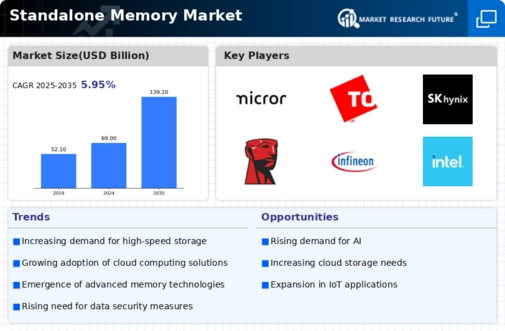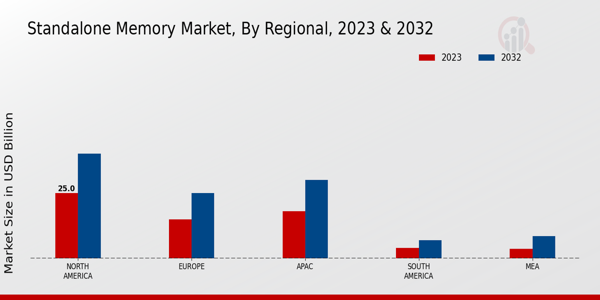Emerging Markets and Economic Growth
Emerging markets are poised to play a crucial role in the expansion of the Global Standalone Memory Market Industry. As economies in regions such as Asia-Pacific and Latin America continue to grow, there is an increasing demand for advanced memory solutions to support industrialization and digital transformation. This growth is driven by rising disposable incomes, urbanization, and the expansion of technology infrastructure. As businesses in these regions invest in modernizing their operations, the demand for standalone memory solutions is likely to increase, further propelling the market forward. This trend suggests a promising outlook for the Global Standalone Memory Market Industry in the coming years.
Market Trends and Growth Projections
The Global Standalone Memory Market Industry is characterized by various trends and growth projections that indicate its future trajectory. The market is expected to experience substantial growth, with projections suggesting it could reach 139.2 USD Billion by 2035. The compound annual growth rate is anticipated to be 6.58% from 2025 to 2035, reflecting the increasing reliance on standalone memory solutions across diverse sectors. This growth is driven by technological advancements, rising data demands, and the proliferation of smart devices. The market trends indicate a robust future for standalone memory, highlighting its essential role in the evolving technological landscape.
Rising Demand for Data Storage Solutions
The Global Standalone Memory Market Industry experiences a surge in demand for data storage solutions, driven by the exponential growth of data generation across various sectors. As organizations increasingly rely on data analytics, cloud computing, and IoT applications, the need for efficient and scalable memory solutions becomes paramount. In 2024, the market is projected to reach 69.0 USD Billion, reflecting the critical role of standalone memory in supporting data-intensive applications. This trend is likely to continue as businesses seek to enhance their operational efficiency and data management capabilities, thereby propelling the growth of the Global Standalone Memory Market Industry.
Growth of Consumer Electronics and Smart Devices
The proliferation of consumer electronics and smart devices significantly impacts the Global Standalone Memory Market Industry. With the increasing demand for smartphones, tablets, and smart home devices, the need for efficient memory solutions is paramount. These devices require high-capacity, fast-access memory to support advanced functionalities and applications. As consumer preferences shift towards more sophisticated technology, manufacturers are compelled to enhance memory capabilities. This trend is expected to contribute to a compound annual growth rate of 6.58% from 2025 to 2035, reflecting the growing importance of standalone memory in the consumer electronics sector.
Technological Advancements in Memory Technologies
Technological advancements in memory technologies significantly influence the Global Standalone Memory Market Industry. Innovations such as 3D NAND, MRAM, and emerging non-volatile memory solutions enhance performance, speed, and reliability. These advancements not only improve the efficiency of data storage but also reduce power consumption, which is increasingly vital in energy-conscious environments. As manufacturers invest in research and development to create next-generation memory solutions, the market is expected to expand further. The anticipated growth trajectory suggests that by 2035, the market could reach 139.2 USD Billion, underscoring the importance of continuous innovation in the standalone memory sector.
Increasing Adoption of Artificial Intelligence and Machine Learning
The integration of artificial intelligence and machine learning technologies into various applications drives the demand for high-performance memory solutions within the Global Standalone Memory Market Industry. These technologies require substantial data processing capabilities, necessitating advanced memory architectures that can handle large datasets efficiently. As industries such as healthcare, finance, and automotive increasingly adopt AI and ML, the need for robust standalone memory solutions becomes more pronounced. This trend indicates a potential for sustained growth, as organizations seek to leverage AI-driven insights, thereby contributing to the overall expansion of the Global Standalone Memory Market Industry.
























Leave a Comment